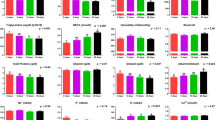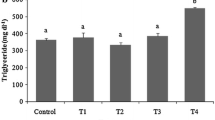Abstract
Plasma growth hormone concentrations of rainbow trout,Oncorhynchus mykiss, fasted for six weeks, were significantly (p < 0.01) higher than in comparable fed animals; in the fasted fish, the levels fell progressively following acute stress (by displacing the fish within their home aquarium), with significant differences from pre-stressed fish evident between one and thirty-two hours after application of the stressor. Plasma growth hormone concentrations also fell significantly in the fed group, but differences were evident only between two and eight hours after stressor application.
Plasma cortisol concentrations in pre- and post-stressed fed and fasted fish were similar. There was a bimodal response to stressor application in both groups, with significantly higher values relative to the pre-stressed sample evident one and eight hours after disturbance, but not after two, four or thirty-two hours. The changes in plasma cortisol levels between the initial (09:00h) sample and the sample taken eight hours later resembles the diet pattern seen in trout given access to self-demand feeders.
Plasma glucose concentrations in pre-stressed fed animals were higher than in pre-stressed fasted fish. This relationship was also evident between one and four hours and thirty-two hours after stressor application. The post-stress rise in plasma glucose concentration was evident between one and four hours in the fed group, and between four and eight hours in fasted fish.
The diel changes in plasma growth hormone and glucose concentrations could not be attributed to normal circadian patterns, and there was no apparent correlation between changes in plasma growth hormone and cortisol concentrations. There was a significant inverse correlation between plasma glucose and growth hormone concentrations when the total data set were analyzed, but these correlations were not apparent when the treatment groups were analyzed separately.
Similar content being viewed by others
References cited
Avella, M., Schreck, C.B. and Prunet, P. 1991. Plasma prolactin and cortisol concentrations of stress coho salmon,Oncorhynchus kisutch, in fresh water or salt water. Gen. Comp. Endocrinol. 81: 21–27.
Bry, C. 1982. Daily variations in plasma cortisol levels of individual female rainbow troutSalmo gairdneri: Evidence for a post-feeding peak in well-adapted fish. Gen. Comp. Endocrinol. 48: 462–468.
Boeuf, G. Le Bail, P.Y. and Prunet, P. 1989. Growth hormone and thyroid hormones during Atlantic salmon,Salmo salar L., smolting, and after transfer to seawater. Aquaculture 82: 257–268.
Björnsson, B.Th., Thorarensen, H., Hirano, T., Ogasawara, T. and Kristinsson, J.B. 1989. Photoperiod and temperature affect plasma growth hormone levels, growth, condition factor and hypoosmo-regulatory ability of juvenile Atlantic salmon (Salmo salar) during parr-smolt transformation. Aquaculture 82: 77–91.
Boujard, T. and Leatherland, J.F. 1992. Diel cycle inOncorhynchus mykiss using demand-feeder and held in different photoperiod regimes: Circadian pattern of food-demand liver composition and hormone concentration. In Fish Nutrition in Practice. Edited by S.J. Kaushik. I.N.R.A., Paris (In press).
Collie, N.L., Bolton, J.P., Kawauchi, H. and Hirano, T. 1989. Survival of salmonids in seawater and the time-frame of growth hormone action. Fish Physiol. Biochem. 7: 315–321.
Carragher, J.F., Sumpter, J.P., Pottinger, T.G. and Pickering, A.D. 1989. The deleterious effects of cortisol implantation on reproductive function in two species of trout,Salmo trutta L. andSalmo gairdneri Richardson. Gen. Comp. Endocrinol. 76: 310–321.
Donaldson, E.M. 1981. The pituitary-interrenal axis as an indicator of stress in fish.In Stress and Fish. pp. 11–47. Edited by A.D. Pickering. Academic Press, London.
Farbridge, K.J., Flett, P.A. and Leatherland, J.F. 1992. Temporal effects of restricted diet and compensatory increased dietary intake on thyroid function, plasma growth hormone levels and tissue lipid reserves of rainbow trout,Oncorhynchus mykiss. Aquaculture (In press).
Farbridge, K.J. and Leatherland, J.F. 1991. The development of a noncompetitive enzyme-linked immunosorbent assay for oncorhyncid growth hormone using monoclonal antibodies. Gen. Comp. Endocrinol. 79: 361–374.
Farbridge, K.J. and Leatherland, J.F. 1992. Correlation between appetite and plasma thyroid, growth hormone and metabolite concentrations in rainbow trout,Oncorhynchus mykiss.In Fish Nutrition in Practice. Edited by S.J. Kaushik. I.N.R.A., Paris. (In press).
Laidley, C.W. and Leatherland, J.F. 1988. Cohort sampling, anaesthesia and stocking-density effects on plasma cortisol, thyroid hormone, metabolite and ion levels in rainbow trout,Salmo gairdneri Richardson. J. Fish Biol. 33: 73–88.
Leatherland, J.F., Farbridge, K.J. and Boujard, T. 1992. Lunar and semi-lunar rhythms in fish.In Rhythms in Fish. Edited by M.A. Ali. Plenum Press, New York (In press).
Leatherland, J.F. and Sonstegard, R.A. 1984. Pathobiological responses of feral teleosts to environmental stressors: Interlake studies of the physiology of Great Lakes salmon.In Contaminant Effects on Fisheries. pp. 116–149. Edited by V.W. Cairns, P.V. Hodson and J.O. Nriagu. John Wiley and Sons, New York.
Picekring, A.D.(Ed.) 1981. Stress and Fish. Academic Press, London.
Pickering, A.D. 1990. Stress and the suppression of somatic growth in teleost fish.In Progress in Comparative Endocrinology. pp. 473–479. Edited by A. Epple, C.G. Scanes and M.H. Stetson. Wiley-Liss, New York.
Prunet, P., Boeuf, G., Bolton, J.P. and Young, G. 1989. Smoltification and seawater adaptation in Atlantic salmon (Salmo salar): Plasma prolactin, growth hormone and thyroid hormones. Gen. Comp. Endocrinol. 74: 355–364.
Rydevik, M., Borg, B., Haux, C., Kawauchi, H. and Björnsson, B.Th. 1990. Plasma growth hormone levels increase during seawater exposure of sexually mature Atlantic salmon parr (Salmo salar L.). Gen. Comp. Endocrinol. 80: 9–15.
Sakamoto, T., Ogasawara, T. and Hirano, T. 1990. Growth hormone kinetics during adaptation to a hyperosmotic environment in rainbow trout. J. Comp. Physiol. 160B: 1–6.
Steel, R.G.D. and Torrie, J.H. 1980. Principles and Procedures of Statistics: A Biometrical Approach. McGraw-Hill, New York.
Sumpter, J.P., Le Bail, P.Y., Pickering, A.D., Pottinger, T.G. and Carragher, J.F. 1991. The effect of starvation on growth and plasma growth hormone concentrations of rainbow trout,Oncorhynchus mykiss. Gen. Comp. Endocrinol. 83: 94–102.
Vijayan, M.M., Flett, P.A. and Leatherland, J.F. 1988. Cortisol effects on the in vitro hepatic conversion of thyroxine to triiodothyronine in brook charr (Salvelinus fontinalis Mitchell). Gen. Comp. Endocrinol. 70: 312–318.
Vijayan, M.M., Ballantyne, J.S. and Leatherland, J.F. 1991. Cortisol-induced changes in some aspects of the intermediary metabolism ofSalvelinus fontinalis. Gen. Comp. Endocrinol. 82: 476–486.
Wagner, G.F. and McKeown, B.A. 1986. Development of a salmon growth hormone radioimmunoassay. Gen. Comp. Endocrinol. 62: 452–458.
Wiik, R., Andersen, K., Uglenes, I. and Egidius, E. 1989. Cortisol-induced increase in susceptibility of Atlantic salmon,Salmo salar to Vibrio salmonicida, together with the effects on blood cell pattern. Aquaculture 83: 201–215.
Woo, P.T.K., Leatherland, J.F. and Lee, M.S. 1987.Cryptobia salmositica: Cortisol increases the susceptibility ofSalmo gairdneri Richardson to experimental cryptobiosis. J. Fish Dis. 10: 75–83.
Young, G., Björnsson, B.Th., Prunet, P., Lin, R.J. and Bern, H.A. 1989. Smoltification and seawater adaptation in coho salmon (Oncorhynchus kisutch): Plasma prolactin, growth hormone, thyroid hormones and cortisol. Gen. Comp. Endocrinol. 74: 335–345.
Author information
Authors and Affiliations
Rights and permissions
About this article
Cite this article
Farbridge, K.J., Leatherland, J.F. Plasma growth hormone levels in fed and fasted rainbow trout (Oncorhynchus mykiss) are decreased following handling stress. Fish Physiol Biochem 10, 67–73 (1992). https://doi.org/10.1007/BF00004655
Accepted:
Issue Date:
DOI: https://doi.org/10.1007/BF00004655




